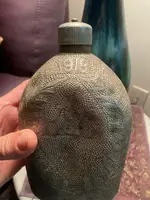I'm going to think a little outside the box here. First of all, a question for our moderators;
Because this was found in a home & not in the field with a metal detector, does it qualify for
Banner consideration ? If it qualifies I would like to give a vote for
Banner.
Because of the beauty & age of the canteen, & given the fact that "IronCityDetector",
who is a collector of military memorabilia, specifically canteens, & has never seen one that intricately engraved, (post #14) I believe it merits my vote.
My mind wanders when I see finds like this & I, like many of you here, enjoy trying to figure out the mysteries behind the object that is found. Sometimes we can find a definitive answer, & sometimes we can't, but there are many knowledgeable people here that have the resources & expertise that, when shared with each other, can have positive results. If not, the effort is well worth it because we all learn new things every day & it's fun!!
In my opinion, I don't think this canteen's artwork could have been completed in one day. So it's curious as to what June 2, 1918 means. Was it the date the canteen was finished, started, or does it commemorate something else ? As "Red-Coat" states in post # 13,
" Difficult to say what the ‘June 2, 1918’ date relates to, except that it doesn’t seem to be a historically important date for the war in that area. More likely, I would think it has some personal significance to a unit or an individual medic being stationed there rather than personal significance to a casualty (given the beautifully engraved caduceus emblem).
"
Is it possible that "KEC" was a "Chief Surgeon" at the hospital complex or a higher up in management ? Is it possible that an expert engraver was commissioned by appreciative patients and/or staff to engrave the canteen that was to be given to a person on the day of their discharge from the military service ? Also, could the canteen have been engraved/created by a skilled professional artisan "stateside" after the recipient returned home ? (Maybe as a gift to be given upon the anticipated return home of the honoree)
Many possibilities as to the who, why, when & where of the canteen, but a great piece of military history nonetheless.
I'm sure there are many veterans of WW1 who had the initials "KEC" or (maybe a medical unit) but that can be narrowed down somewhat to those who passed through the Savenay Hospital complex during the war. A good start would be to contact the people at the museum at Fort Devens. They were interested enough to show a film about it & must have all kinds of records, or, at the very least, they can steer you (bergie) in a more helpful direction.
Best wishes and thanks for sharing your beautiful find.









